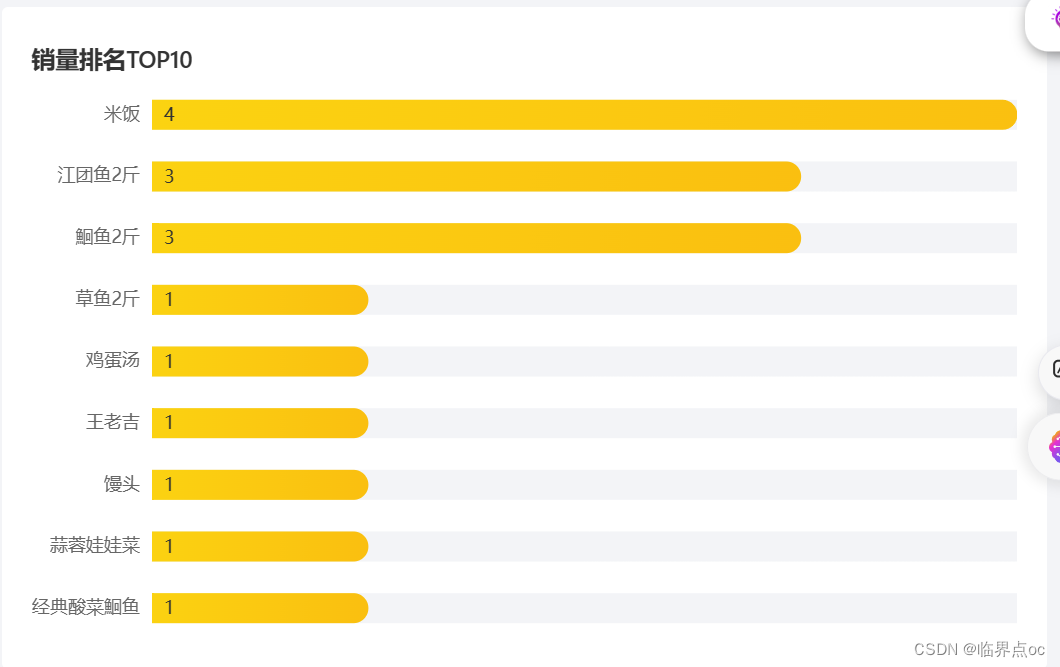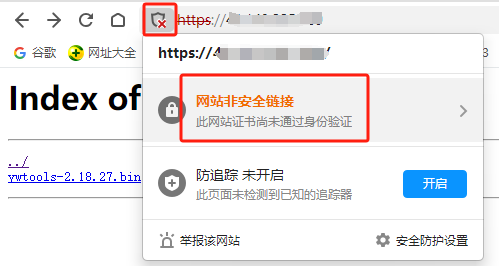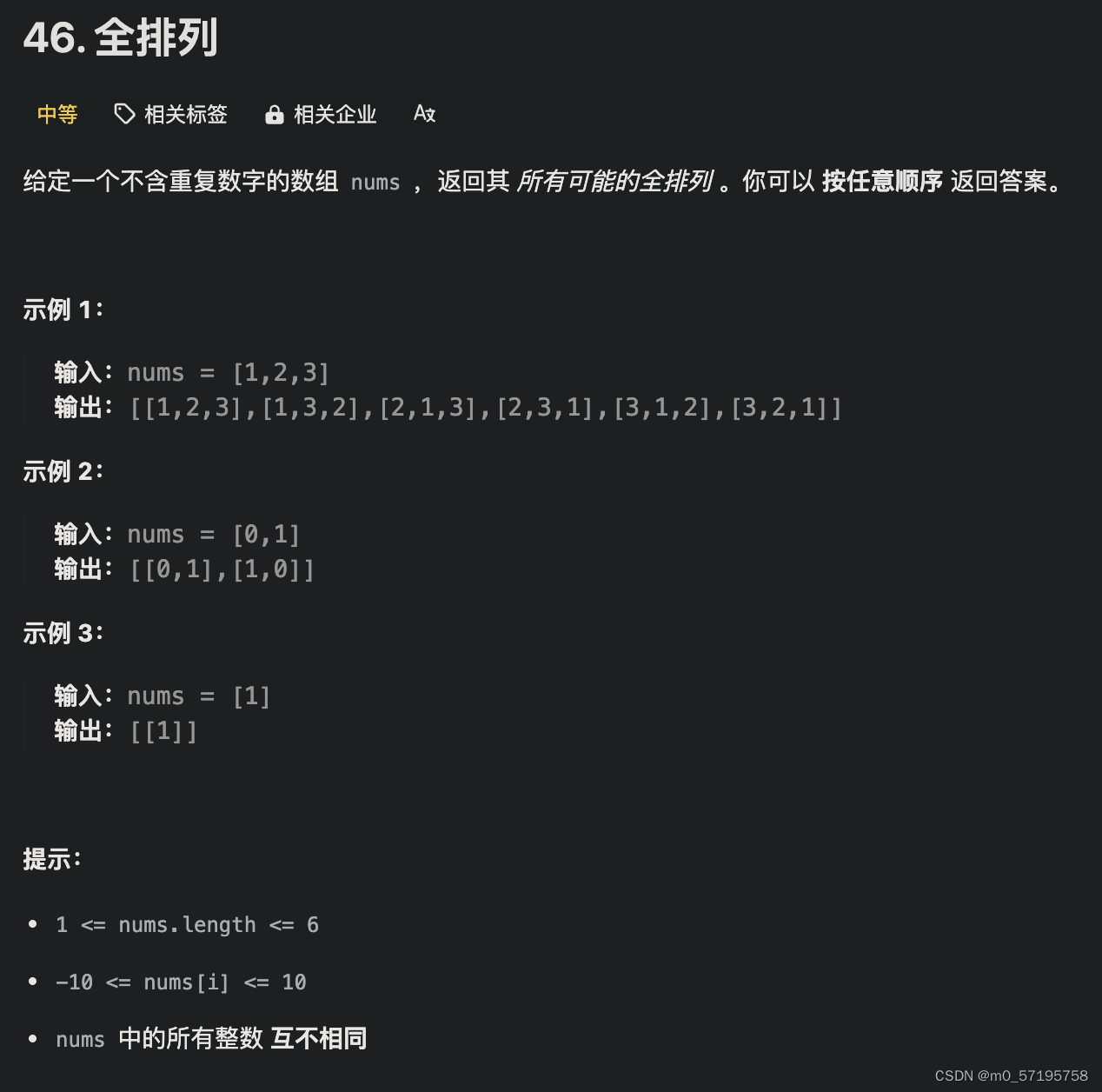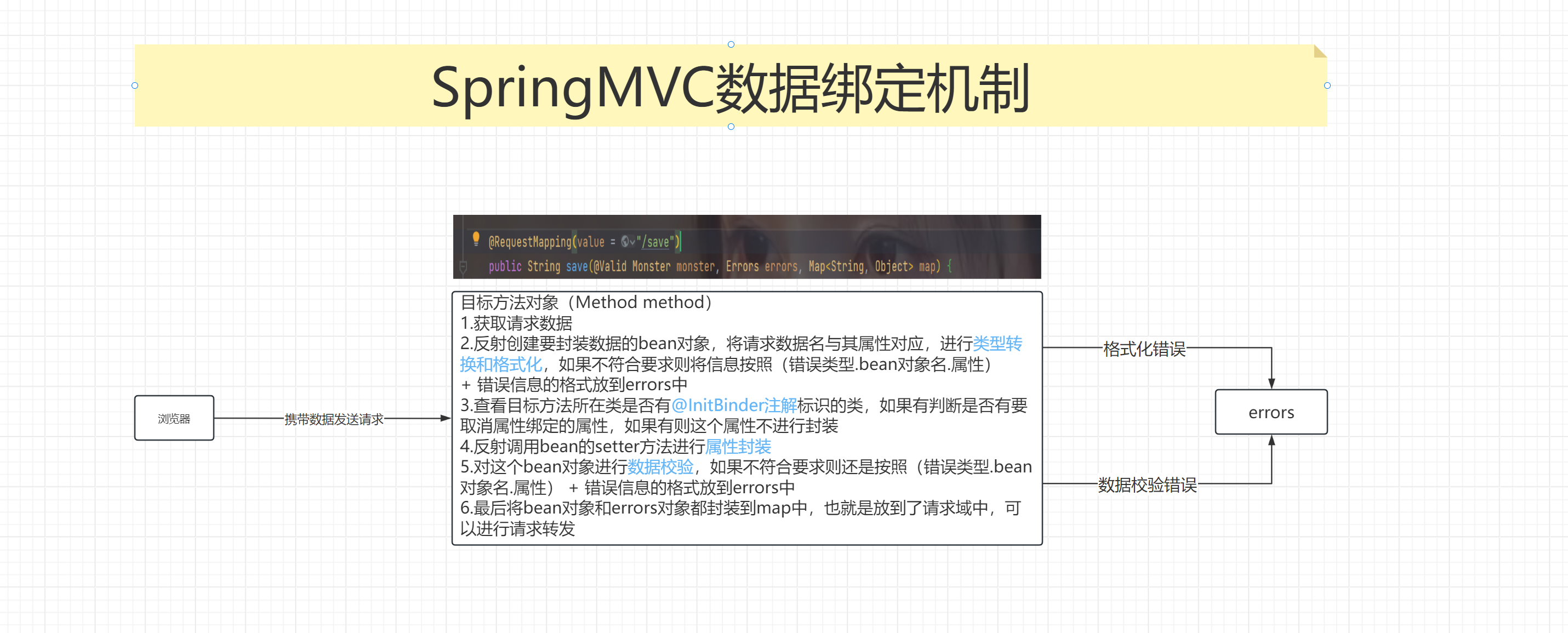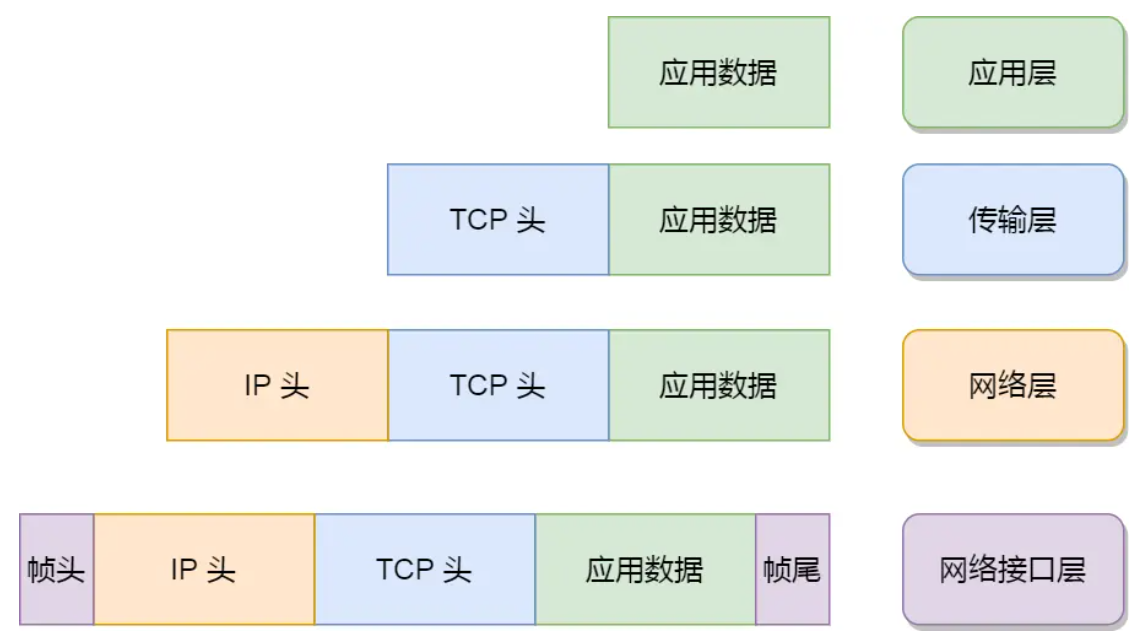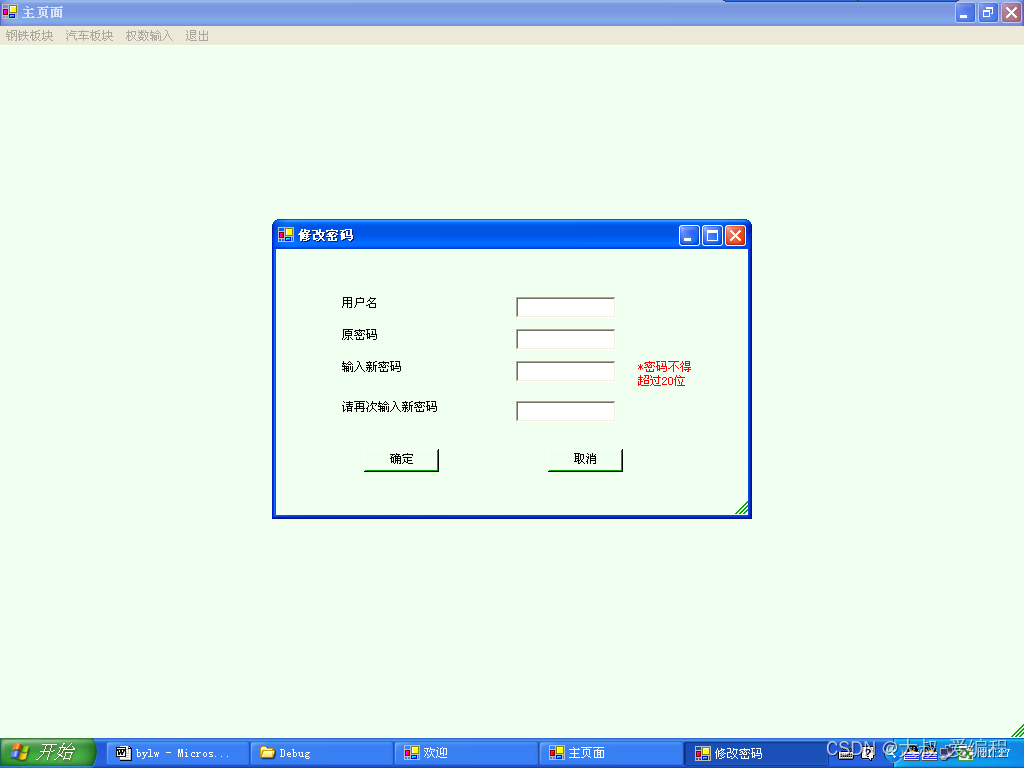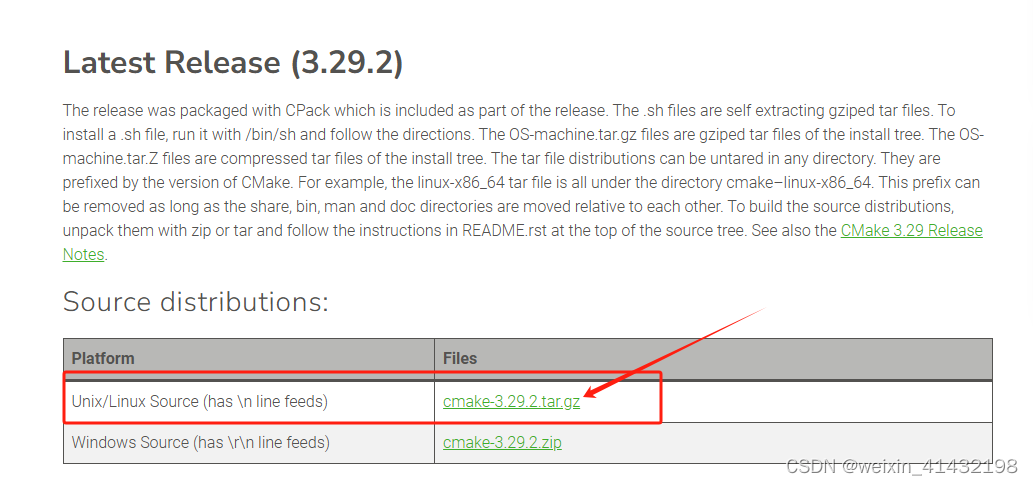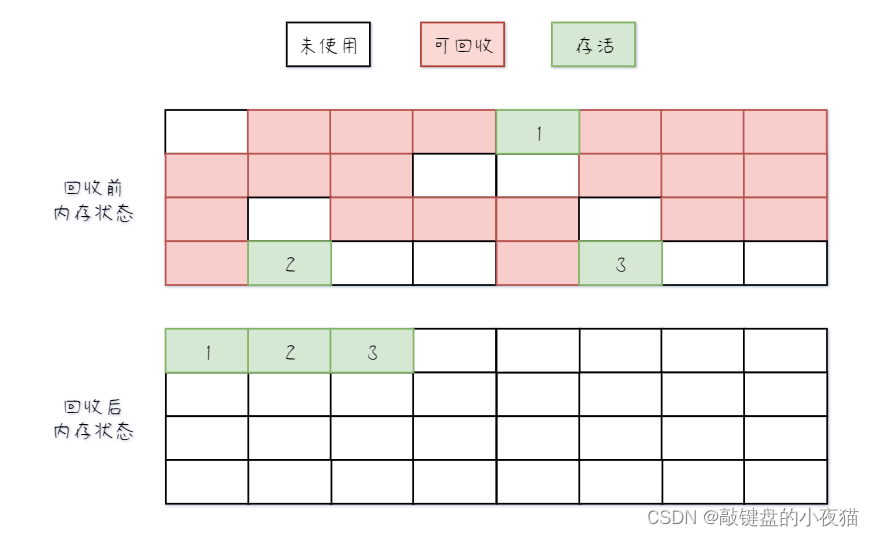一、Apache ECharts
介绍
Apache ECharts是一款基于javascript的数据可视化图标库,提供直观、生动、可交互、可个性化定制的数据可视化图表。
官网地址:https://echarts.apache.org/zh/index.html

效果展示
- 柱形图

- 饼图

- 折线图

入门案例
1. 在 echarts CDN by jsDelivr - A CDN for npm and GitHub 选择 dist/echarts.js,点击并保存为 echarts.js 文件
2. 编写入门案列
<!DOCTYPE html>
<html>
<head>
<meta charset="utf-8" />
<title>ECharts</title>
<!-- 引入刚刚下载的 ECharts 文件 -->
<script src="echarts.js"></script>
</head>
<body>
<!-- 为 ECharts 准备一个定义了宽高的 DOM -->
<div id="main" style="width: 600px;height:400px;"></div>
<script type="text/javascript">
// 基于准备好的dom,初始化echarts实例
var myChart = echarts.init(document.getElementById('main'));
// 指定图表的配置项和数据
var option = {
title: {
text: 'ECharts 入门示例'
},
tooltip: {},
legend: {
data: ['销量']
},
xAxis: {
data: ['衬衫', '羊毛衫', '雪纺衫', '裤子', '高跟鞋', '袜子']
},
yAxis: {},
series: [
{
name: '销量',
type: 'bar',
data: [5, 20, 36, 10, 10, 20]
}
]
};
// 使用刚指定的配置项和数据显示图表。
myChart.setOption(option);
</script>
</body>
</html>效果:
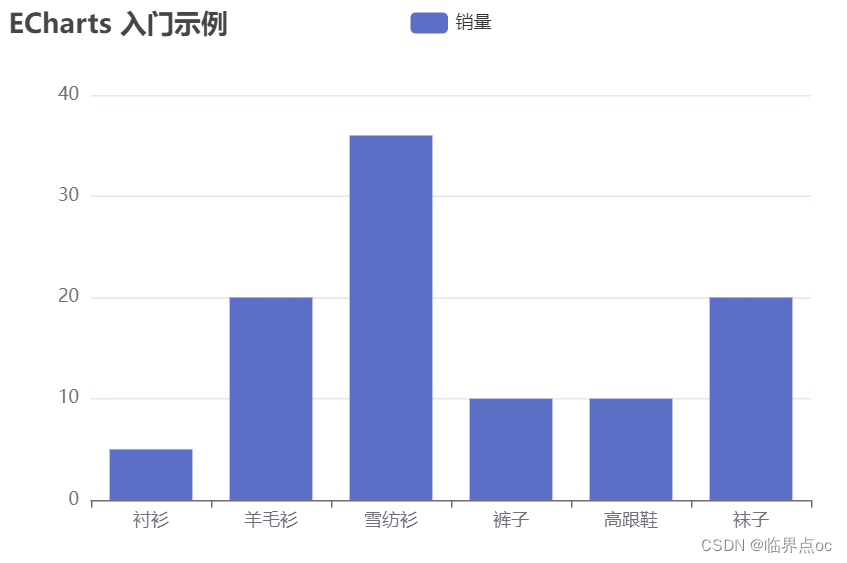
总结:使用ECharts,重点在于研究当前图标所需的数据格式。通常是需要后端提供符合格式要求的动态数据,然后响应给前端来展示图表。
二、营业额统计
需求分析和设计

业务规则:
- 营业额指订单状态为已完成的订单金额统计
- 基于可视化报表的折线图展示营业额数据,x轴为日期,y轴为营业额
- 根据时间选择区间,展示每天都营业额数据
接口设计

根据接口定义设计对应的VO:

代码开发
1. 创建一个新的Controller,即admin/ReportController
package com.sky.controller.admin;
import com.sky.result.Result;
import com.sky.service.ReportService;
import com.sky.vo.TurnoverReportVO;
import io.swagger.annotations.Api;
import io.swagger.annotations.ApiOperation;
import lombok.extern.slf4j.Slf4j;
import org.springframework.beans.factory.annotation.Autowired;
import org.springframework.format.annotation.DateTimeFormat;
import org.springframework.web.bind.annotation.GetMapping;
import org.springframework.web.bind.annotation.RequestMapping;
import org.springframework.web.bind.annotation.RestController;
import java.time.LocalDate;
/**
* 数据统计相关接口
*/
@RestController
@RequestMapping("/admin/report")
@Api(tags = "数据统计相关接口")
@Slf4j
public class ReportController {
@Autowired
private ReportService reportService;
/**
* 营业额统计
* @param begin
* @param end
* @return
*/
@GetMapping("/turnoverStatistics")
@ApiOperation("营业额统计")
public Result<TurnoverReportVO> turnoverStatistics(@DateTimeFormat(pattern = "yyyy-MM-dd") LocalDate begin, @DateTimeFormat(pattern = "yyyy-MM-dd") LocalDate end) {
log.info("营业额数据统计:{}, {}", begin, end);
return Result.success(reportService.getTurnoverStatistics(begin, end));
}
}
2. ReportService
package com.sky.service;
import com.sky.vo.TurnoverReportVO;
import java.time.LocalDate;
public interface ReportService {
/**
* 统计指定时间区间内的营业额
* @param begin
* @param end
* @return
*/
TurnoverReportVO getTurnoverStatistics(LocalDate begin, LocalDate end);
}
3. ReportServiceImpl
注意StringUtils导的是import org.apache.commons.lang3.StringUtils;
package com.sky.service.impl;
import com.sky.entity.Orders;
import com.sky.mapper.OrderMapper;
import com.sky.service.ReportService;
import com.sky.vo.TurnoverReportVO;
import lombok.extern.slf4j.Slf4j;
import org.apache.commons.lang3.StringUtils;
import org.springframework.beans.factory.annotation.Autowired;
import org.springframework.stereotype.Service;
import java.time.LocalDate;
import java.time.LocalDateTime;
import java.time.LocalTime;
import java.util.ArrayList;
import java.util.HashMap;
import java.util.List;
import java.util.Map;
@Service
@Slf4j
public class ReportServiceImpl implements ReportService {
@Autowired
private OrderMapper orderMapper;
/**
* 统计指定时间区间内的营业额
* @param begin
* @param end
* @return
*/
@Override
public TurnoverReportVO getTurnoverStatistics(LocalDate begin, LocalDate end) {
// 当前集合用于存放从begin到end范围内的每天的日期
List<LocalDate> dateList = new ArrayList<>();
dateList.add(begin);
while(!begin.equals(end)) {
// 日期计算,计算指定日期的后一天对应的日期
begin = begin.plusDays(1);
dateList.add(begin);
}
// 存放每天的营业额
List<Double> turnoverList = new ArrayList();
for (LocalDate date : dateList) {
// 查询date日期对应的营业额数据,指状态为“已完成”的订单金额合计
// 一天的开始时间
LocalDateTime beginTime = LocalDateTime.of(date, LocalTime.MIN);
// 一天的结束时间
LocalDateTime endTime = LocalDateTime.of(date, LocalTime.MAX);
// select sum(amount) from orders where order_time > beginTime and order_time < endTime and status = 5
Map map = new HashMap();
map.put("begin", beginTime);
map.put("end", endTime);
map.put("status", Orders.COMPLETED);
Double turnover = orderMapper.sumByMap(map);
// 判空
turnover = turnover == null ? 0.0 : turnover;
turnoverList.add(turnover);
}
// 封装返回结果
return TurnoverReportVO
.builder()
.dateList(StringUtils.join(dateList, ","))
.turnoverList(StringUtils.join(turnoverList, ","))
.build();
}
}
4. OrderMapper
/**
* 根据动态条件统计营业额数据
* @param map
* @return
*/
Double sumByMap(Map map);5. OrderMapper.xml
<select id="sumByMap" resultType="java.lang.Double">
select sum(amount) from orders
<where>
<if test="begin != null">
and order_time > #{begin}
</if>
<if test="end != null">
and order_time < #{end}
</if>
<if test="status != null">
and status = #{status}
</if>
</where>
</select>在XML文件中,有一些特殊字符需要使用实体编码表示,以避免与XML语法冲突,如:
- < :小于号(<)
- > : 大于号(>)
- & : 与号(&)
- " : 双引号(")
- &apos : 单引号(')
:空格©:版权符号(©)®:注册商标符号(®)€:欧元符号(€)¥:日元符号(¥)£:英镑符号(£)
功能测试

三、用户统计
需求分析和设计
产品原型

业务规则
- 基于可视化报表的折线图展示用户数据,x轴为日期,y轴为用户数
- 根据时间选择区间,展示每天的用户总量和新增用户数据
接口设计
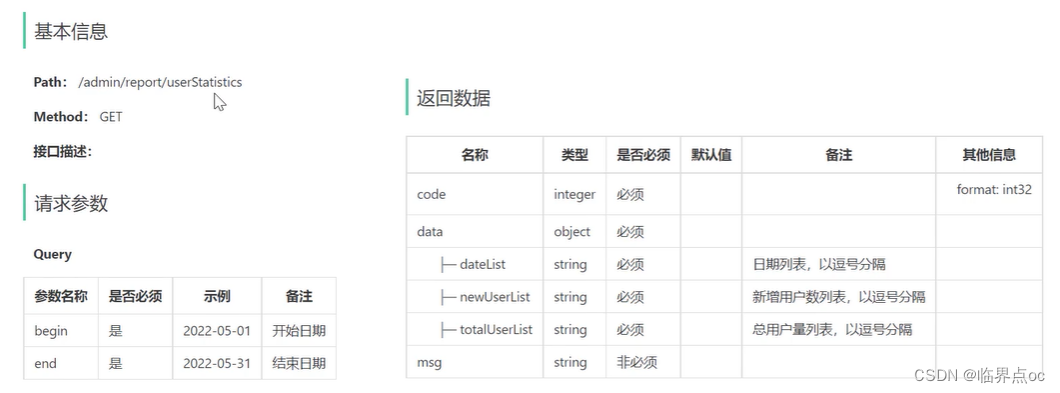
代码开发

1. ReportController
/**
* 用户统计
* @param begin
* @param end
* @return
*/
@GetMapping("/userStatistics")
@ApiOperation("用户统计")
public Result<UserReportVO> userStatistics(@DateTimeFormat(pattern = "yyyy-MM-dd") LocalDate begin, @DateTimeFormat(pattern = "yyyy-MM-dd") LocalDate end) {
log.info("用户数据统计:{}, {}", begin, end);
return Result.success(reportService.getUserStatistics(begin, end));
}2. ReportService
/**
* 统计指定时间区间内的用户数据
* @param begin
* @param end
* @return
*/
UserReportVO getUserStatistics(LocalDate begin, LocalDate end);3. ReportServiceImpl
@Autowired
private UserMapper userMapper;
/**
* 统计指定时间区间内的用户数据
* @param begin
* @param end
* @return
*/
@Override
public UserReportVO getUserStatistics(LocalDate begin, LocalDate end) {
// 当前集合用于存放从begin到end范围内的每天的日期
List<LocalDate> dateList = new ArrayList<>();
dateList.add(begin);
while(!begin.equals(end)) {
// 日期计算,计算指定日期的后踢腿对应的日期
// LocalDate类的plusDays方法并不会修改原始的LocalDate对象,而是返回一个新的LocalDate对象
begin = begin.plusDays(1);
dateList.add(begin);
}
// 存放每天的新增用户数量
// select count(id) from user where create_time < ? and create_time > ?
List<Integer> newUserList = new ArrayList<>();
// 存放每天的总用户数量
// select count(id) from user where create_time < ?
List<Integer> totalUserList = new ArrayList<>();
for (LocalDate date : dateList) {
// 统计每天的新增用户数量以及每天的总用户数量
// 一天的开始时间
LocalDateTime beginTime = LocalDateTime.of(date, LocalTime.MIN);
// 一天的结束时间
LocalDateTime endTime = LocalDateTime.of(date, LocalTime.MAX);
Map map = new HashMap();
map.put("end", endTime);
// 总用户数量
Integer totalUser = userMapper.countByMap(map);
map.put("begin", beginTime);
// 新增用户数量
Integer newUser = userMapper.countByMap(map);
totalUserList.add(totalUser);
newUserList.add(newUser);
}
// 封装返回结果
return UserReportVO
.builder()
.dateList(StringUtils.join(dateList, ","))
.totalUserList(StringUtils.join(totalUserList, ","))
.newUserList(StringUtils.join(newUserList, ","))
.build();
}4. UserMapper
/**
* 根据动态条件统计用户数量
* @return
*/
Integer countByMap(Map map);5. UserMapper.xml
<select id="countByMap" resultType="java.lang.Integer">
select count(id) from orders
<where>
<if test="begin != null">
and order_time > #{begin}
</if>
<if test="end != null">
and order_time < #{end}
</if>
<if test="status != null">
and status = #{status}
</if>
</where>
</select>功能测试

四、订单统计
需求分析和设计
产品原型
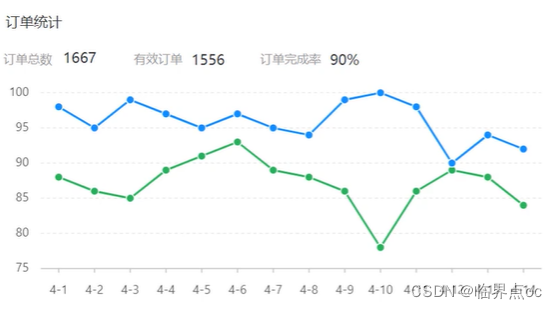
业务规则
- 有效订单指状态为”已完成“的订单
- 基于可视化报表的折线图展示订单数据,x轴为日期,y轴为订单数量
- 根据时间选择区间,展示每天的订单总数和有效订单数
- 展示所选时间区间内的有效订单数、总订单数、订单完成率,订单完成率 = 有效订单数 / 总订单数 * 100%。
接口设计

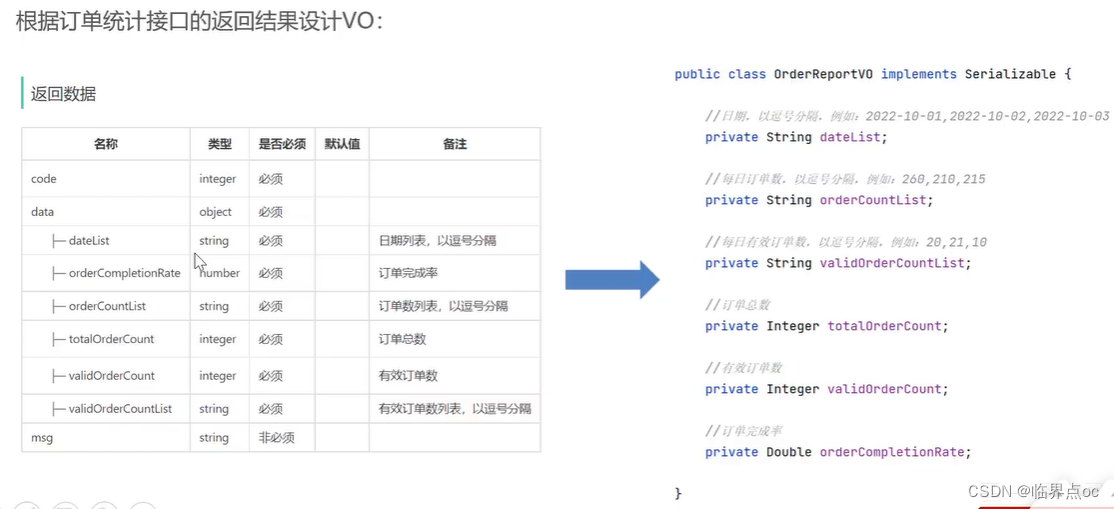
代码开发
1. ReportController
注意不要写错路径
/**
* 订单统计
* @param begin
* @param end
* @return
*/
@GetMapping("/ordersStatistics")
@ApiOperation("订单统计")
public Result<OrderReportVO> orderStatistics(@DateTimeFormat(pattern = "yyyy-MM-dd") LocalDate begin, @DateTimeFormat(pattern = "yyyy-MM-dd") LocalDate end) {
log.info("订单数据统计:{}, {}", begin, end);
return Result.success(reportService.getOrderStatistics(begin, end));
}2. ReportService
/**
* 统计指定时间区间内的订单数据
* @param begin
* @param end
* @return
*/
OrderReportVO getOrderStatistics(LocalDate begin, LocalDate end);3. ReportServiceImpl
/**
* 统计指定时间区间内的订单数据
* @param begin
* @param end
* @return
*/
@Override
public OrderReportVO getOrderStatistics(LocalDate begin, LocalDate end) {
// 当前集合用于存放从begin到end范围内的每天的日期
List<LocalDate> dateList = new ArrayList<>();
dateList.add(begin);
while(!begin.equals(end)) {
// 日期计算,计算指定日期的后踢腿对应的日期
// LocalDate类的plusDays方法并不会修改原始的LocalDate对象,而是返回一个新的LocalDate对象
begin = begin.plusDays(1);
dateList.add(begin);
}
// 存放每天的订单总数
List<Integer> orderCountList = new ArrayList<>();
// 存放每天的有效订单总数
List<Integer> validOrderCountList = new ArrayList<>();
// 遍历dateList集合,查询每天的有效订单数和订单总数
for (LocalDate date : dateList) {
// 一天的开始时间
LocalDateTime beginTime = LocalDateTime.of(date, LocalTime.MIN);
// 一天的结束时间
LocalDateTime endTime = LocalDateTime.of(date, LocalTime.MAX);
// 查询每天的订单总数
// select count(id) from orders where order_time > ? and order_time < ?
Integer orderCount = getOrderCount(beginTime, endTime, null);
// 查询每天的有效订单总数
// select count(id) from orders where order_time > ? and order_time < ? and status = 5
Integer validOrderCount = getOrderCount(beginTime, endTime, Orders.COMPLETED);
orderCountList.add(orderCount);
validOrderCountList.add(validOrderCount);
}
// 计算时间区间内的订单总数量
Integer totalOrderCount = orderCountList.stream().reduce(Integer::sum).get();
// 计算时间区间内的有效订单总数量
Integer validOrderCount = validOrderCountList.stream().reduce(Integer::sum).get();
// 计算订单完成率
Double orderCompletionRate = 0.0;
if(totalOrderCount != 0) {
orderCompletionRate = validOrderCount.doubleValue() / totalOrderCount;
}
// 封装返回结果
return OrderReportVO
.builder()
.dateList(StringUtils.join(dateList, ","))
.orderCountList(StringUtils.join(orderCountList, ","))
.validOrderCountList(StringUtils.join(validOrderCountList, ","))
.totalOrderCount(totalOrderCount)
.validOrderCount(validOrderCount)
.orderCompletionRate(orderCompletionRate)
.build();
}
private Integer getOrderCount(LocalDateTime begin, LocalDateTime end, Integer status) {
Map map = new HashMap();
map.put("begin", begin);
map.put("end", end);
map.put("status", status);
return orderMapper.countByMap(map);
}4. OrderMapper
/**
* 根据动态条件统计订单数量
* @param map
* @return
*/
Integer countByMap(Map map);5. OrderMapper.xml
<select id="countByMap" resultType="java.lang.Integer">
select count(id) from orders
<where>
<if test="begin != null">
and order_time > #{begin}
</if>
<if test="end != null">
and order_time < #{end}
</if>
<if test="status != null">
and status = #{status}
</if>
</where>
</select>功能测试

五、销量排名Top10
需求分析和设计
产品原型

业务规则
- 根据时间选择区间,展示销量前10的商品(包括菜品和套餐)
- 基于可视化报表的柱状图展示商品销量
- 此处的销量为商品销售的份数
接口设计

代码开发

1. ReportController
/**
* 销量排名top10
* @param begin
* @param end
* @return
*/
@GetMapping("/top10")
@ApiOperation("销量排名top10")
public Result<SalesTop10ReportVO> top10(@DateTimeFormat(pattern = "yyyy-MM-dd") LocalDate begin, @DateTimeFormat(pattern = "yyyy-MM-dd") LocalDate end) {
log.info("销量排名top10:{}, {}", begin, end);
return Result.success(reportService.getSalesTop10(begin, end));
}2. ReportService
/**
* 统计指定时间区间内的销量排名top10
* @param begin
* @param end
* @return
*/
SalesTop10ReportVO getSalesTop10(LocalDate begin, LocalDate end);3. ReportServiceImpl
/**
* 统计指定时间区间内的销量排名top10
* @param begin
* @param end
* @return
*/
@Override
public SalesTop10ReportVO getSalesTop10(LocalDate begin, LocalDate end) {
LocalDateTime beginTime = LocalDateTime.of(begin, LocalTime.MIN);
LocalDateTime endTime = LocalDateTime.of(end, LocalTime.MAX);
List<GoodsSalesDTO> salesTop10 = orderMapper.getSalesTop10(beginTime, endTime);
List<String> names = salesTop10.stream().map(GoodsSalesDTO::getName).collect(Collectors.toList());
String nameList = StringUtils.join(names, ",");
List<Integer> numbers = salesTop10.stream().map(GoodsSalesDTO::getNumber).collect(Collectors.toList());
String numberList = StringUtils.join(numbers, ",");
// 封装返回结果数据
return SalesTop10ReportVO
.builder()
.nameList(nameList)
.numberList(numberList)
.build();
}4. OrderMapper
/**
* 统计指定时间区间内的销量排名前10
* @param begin
* @param end
* @return
*/
List<GoodsSalesDTO> getSalesTop10(LocalDateTime begin, LocalDateTime end);5. OrderMapper.xml
<select id="getSalesTop10" resultType="com.sky.dto.GoodsSalesDTO">
select od.name, sum(od.number) number
from order_detail od, orders o
where od.order_id = o.id and o.status = 5
<if test="begin != null">
and o.order_time > #{begin}
</if>
<if test="end != null">
and o.order_time < #{end}
</if>
group by od.name
order by number desc
limit 0,10
</select>功能测试
